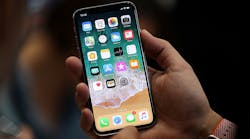Apple Inc. has lost its supply chain mojo.
While consumers remember the iPhone for its cool design, closed-wall operating system and hefty price tag, industry insiders in Asia turn to the U.S. giant as an example of incredible manufacturing discipline.
First under Tim Cook, and now under current COO Jeff Williams, Apple has shone as a beacon of how to discover and develop unique materials, coerce and cajole suppliers, and churn out millions of units all without owning any factories.
By now, everyone has heard about delays in the supply chain. But analysts have so far forgiven Apple, with full-year sales forecasts swinging by a mere 1.5% in the past six months.
A look at its key suppliers shows a different story. Thanks to Taiwan rules requiring the disclosure of monthly sales, we can track endemic weakness at its exclusive processor maker Taiwan Semiconductor Manufacturing Co. and primary assembler Hon Hai Precision Industry Co. Camera module maker Largan Precision Co. is also showing relative weakness.
Analysts and investors seem to believe this is all just one minor hiccup and things will be fine. But the delayed production, caused by multiple component bottlenecks, has shown a gap in the armor.
I’m concerned that it’s not a momentary lapse. The multiple failures in this year’s output make me wonder whether Apple has decision-making problems at its most senior levels.
A series of pile-ups along the supply chain can be traced back to one fundamental choice made many months ago: picking organic light emitting diode screens (OLED) for this year’s iPhone.
The benefits of OLED are numerous, and I won’t go into them, with rivals including Samsung Electronics Co. already using the screens.
If there’s one company on the planet that understands the electronics supply chain in minute detail, it’s Apple. The company is unique in the way its teams of product managers work intimately with component makers to assess technology, capability and capacity. Where necessary, Apple even buys equipment to be deployed in a supplier’s factory to help boost throughput.
So when Cupertino decided to go with OLED, it must have known that supply would be tight and the company would be relying on nemesis Samsung. Perhaps Cook and Williams were OK with this and figured Samsung would ramp up fast enough to ensure OLEDs for all, or maybe they thought alternative suppliers would come on stream. Clearly they were wrong. Apple does mess up from time to time — Scratchgate being a good example — but this mistake was huge.
Earlier in the year, Apple seemed to have understood this miscalculation and decided to split the launch in order to alleviate pressure, giving us two products: iPhone 8 (using traditional LCD) and iPhone X (with OLED). That was another mistake. I have written before about the folly of introducing cheap versus premium products at the same time. But this was only the start of what may become Apple’s manufacturing annus horribilis.
In proceeding with OLED, the company was faced with a new challenge: making fingerprint sensors work through an OLED screen. It failed and Apple had to dump the idea, instead turning to facial recognition. This was already likely to be a feature, but with Touch ID now gone, Face ID was front and center (Apple couldn’t well go back to humdrum passwords). That means reliance on Romeo and Juliet, the two-part sensor module crucial to making it work. But again, Apple misjudged the supply chain and was left with bottlenecks, as the Wall Street Journal outlined last month.
Remember, the whole saga started with the decision to move ahead with OLED knowing that supply wasn’t assured, and has turned into the nursery rhyme about an Old Lady Who Swallowed a Fly.
If this truly is a single-cycle mistake, then it’s possible Apple will return to its former glory. If the problems are a result of hubris then it indicates to me that Apple has lost its mojo.
With rival brands like Samsung and Huawei becoming increasingly adept at working with suppliers, Apple risks losing its hardware edge at a time when its iOS platform is also under fire. It simply can’t afford to make such a mistake again.
By Tim Culpan, a technology columnist for Bloomberg Gadfly. This column does not necessarily reflect the opinion of Bloomberg LP and its owners.




